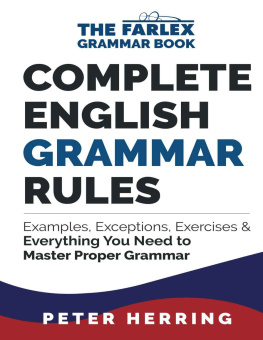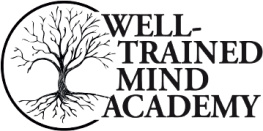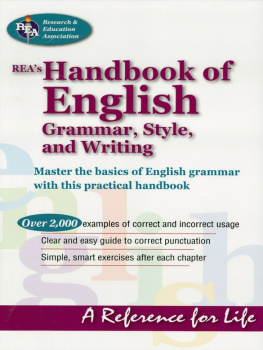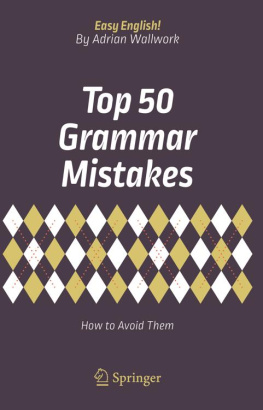Peter Herring - Complete English Grammar Rules: Examples, Exceptions, Exercises, and Everything You Need to Master Proper Grammar
Here you can read online Peter Herring - Complete English Grammar Rules: Examples, Exceptions, Exercises, and Everything You Need to Master Proper Grammar full text of the book (entire story) in english for free. Download pdf and epub, get meaning, cover and reviews about this ebook. year: 2016, publisher: Farlex International, genre: Children. Description of the work, (preface) as well as reviews are available. Best literature library LitArk.com created for fans of good reading and offers a wide selection of genres:
Romance novel
Science fiction
Adventure
Detective
Science
History
Home and family
Prose
Art
Politics
Computer
Non-fiction
Religion
Business
Children
Humor
Choose a favorite category and find really read worthwhile books. Enjoy immersion in the world of imagination, feel the emotions of the characters or learn something new for yourself, make an fascinating discovery.
- Book:Complete English Grammar Rules: Examples, Exceptions, Exercises, and Everything You Need to Master Proper Grammar
- Author:
- Publisher:Farlex International
- Genre:
- Year:2016
- Rating:5 / 5
- Favourites:Add to favourites
- Your mark:
- 100
- 1
- 2
- 3
- 4
- 5
Complete English Grammar Rules: Examples, Exceptions, Exercises, and Everything You Need to Master Proper Grammar: summary, description and annotation
We offer to read an annotation, description, summary or preface (depends on what the author of the book "Complete English Grammar Rules: Examples, Exceptions, Exercises, and Everything You Need to Master Proper Grammar" wrote himself). If you haven't found the necessary information about the book — write in the comments, we will try to find it.
Peter Herring: author's other books
Who wrote Complete English Grammar Rules: Examples, Exceptions, Exercises, and Everything You Need to Master Proper Grammar? Find out the surname, the name of the author of the book and a list of all author's works by series.
Complete English Grammar Rules: Examples, Exceptions, Exercises, and Everything You Need to Master Proper Grammar — read online for free the complete book (whole text) full work
Below is the text of the book, divided by pages. System saving the place of the last page read, allows you to conveniently read the book "Complete English Grammar Rules: Examples, Exceptions, Exercises, and Everything You Need to Master Proper Grammar" online for free, without having to search again every time where you left off. Put a bookmark, and you can go to the page where you finished reading at any time.
Font size:
Interval:
Bookmark:
The Farlex Grammar Book:
Complete English Grammar Rules
FARLEX International
Copyright 2016 Farlex International
All rights reserved.
ISBN: 1535231688
ISBN-13: 978-1535231688
Table of contents
Peter Herring was born in Boulder, Colorado, and grew up with a passion for reading. He attended the University of British Columbia, in Vancouver, Canada, where he majored in English Literature. He went on to complete a masters degree in Anglo-Irish Literature and Drama at University College Dublin in Ireland, where he graduated with honors.
Peter has worked as an editor since 2009, lending his passion for words to scientific research projects, non-fiction publishing, and The Free Dictionary.
He lives in Dublin, Ireland, with his wife and son.
About the editor
Nick Norlen is the managing editor of The Free Dictionary, where he oversees all editorial projects. After graduating with honors from La Salle University in Philadelphia, he worked as a reporter before joining the Farlex team in 2008.
He lives in Newtown, Pennsylvania, with his wife and daughter, whose first word is his favorite word.
Grammar is without a doubt one of the most daunting aspects of the English language, an area riddled with complexities, inconsistencies, and contradictions. It has also been in a state of flux for pretty much its entire existence. For native speakers of English, as well as for those learning it as a new language, grammar presents a very serious challenge to speaking and writing both accurately and effectively.
Having a single, reliable, go-to reference guide should therefore be indispensable to those trying to learn, improve, or perfect their speech or writing. This book is that guide: a clear, unambiguous, and comprehensive source of information that covers all the relevant topics of English grammar, while still being easy to understand and enjoyable to read.
Every topic in the book has been broken down into basic units. Each unit can be read and understood in its own right, but throughout the book you will find cross-references to other sections and chapters to help make it clear how all the pieces fit together. If youre having trouble understanding something, try going back (or forward) to other related topics in the book.
Finally, it must be mentioned that, because English is such a flexible, inconsistent language, the rules that are often bandied about are usually not rules at all, but rather guides that reflect how the language is used. Accordingly, the guidelines contained within this book are just thatguidelines. They are not intended to provide constrictive or proscriptive rules that confine everyone to a particular way of speaking or writing.
Learning how the English language works will enhance your engagement with speech and writing every day, from the books you read, to the e-mails you write, to the conversations you have with friends and strangers alike.
As such, mastering grammar is not an exercise that is confined to the classroom. While it is certainly important to learn the structures, styles, and rules that shape the language, the key to truly learning English is to read and listen to the way people write and speak every day, from the most well-known authors to the people you talk to on the bus. Take the information you find in this book and carry it with you into the world.
-P. Herring
This book is written according to the standard styles and spellings used in American English. While major differences between American and British English are usually addressed, some information in the book might not coincide with the styles, tendencies, or preferences of other English-speaking communities.
Grammar refers to the way words are used, classified, and structured together to form coherent written or spoken communication.
This guide takes a traditional approach to teaching English grammar, breaking the topic into three fundamental elements: Parts of Speech , Inflection , and Syntax . Each of these is a discrete, individual part, but they are all intrinsically linked together in meaning.
Parts of Speech
In the first part of the guide, we will look at the basic components of Englishwords. The parts of speech are the categories to which different words are assigned, based on their meaning, structure, and function in a sentence.
Well look in great detail at the seven main parts of speech nouns , pronouns , verbs , adjectives , adverbs , prepositions , and conjunctions as well as other categories of words that dont easily fit in with the rest, such as particles , determiners , and gerunds .
By understanding the parts of speech, we can better understand how (and why) we structure words together to form sentences.
Inflection
Although the parts of speech provide the building blocks for English, another very important element is inflection , the process by which words are changed in form to create new, specific meanings.
There are two main categories of inflection: conjugation and declension . Conjugation refers to the inflection of verbs, while declension refers to the inflection of nouns, pronouns, adjectives, and adverbs. Whenever we change a verb from the present tense to the past tense , for example, we are using conjugation . Likewise, when we make a noun plural to show that there is more than one of it, we are using declension .
Syntax
The third and final part of the guide will focus on syntax , the rules and patterns that govern how we structure sentences. The grammatical structures that constitute syntax can be thought of as a hierarchy, with sentences at the top as the largest cohesive unit in the language and words (the parts of speech) at the bottom.
Well begin the third part by looking at the basic structural units present in all sentences subjects and predicates and progressively move on to larger classes of structures, discussing modifiers , phrases , and clauses . Finally, we will end by looking at the different structures and categories of sentences themselves.
Using the three parts together
The best way to approach this guide is to think of it as a cross-reference of itself; when you see a term or concept in one section that youre unfamiliar with, check the other sections to find a more thorough explanation. Neither parts of speech nor inflection nor syntax exist as truly separate units; its equally important to examine and learn about the different kinds of words, how they can change to create new meaning, and the guidelines by which they are structured into sentences.
When we learn to use all three parts together, we gain a much fuller understanding of how to make our speech and writing not only proper, but natural and effective.
Definition
The parts of speech are the primary categories of words according to their function in a sentence.
English has seven main parts of speech. Well look at a brief overview of each below; continue on to their individual chapters to learn more about them.
Nouns
Nouns are words that identify or name people, places, or things. Nouns can function as the subject of a clause or sentence, an object of a verb, or an object of a preposition. Words like cat, book, table, girl , and plane are all nouns.
Pronouns
Pronouns are words that represent nouns (people, places, or things). Grammatically, pronouns are used in the same ways as nouns; they can function as subjects or objects. Common pronouns include I, you, she, him, it, everyone , and somebody .
Verbs
Verbs are words that describe the actionsor states of beingof people, animals, places, or things. Verbs function as the root of whats called the predicate , which is required (along with a subject) to form a complete sentence; therefore, every sentence must include at least one verb.
Font size:
Interval:
Bookmark:
Similar books «Complete English Grammar Rules: Examples, Exceptions, Exercises, and Everything You Need to Master Proper Grammar»
Look at similar books to Complete English Grammar Rules: Examples, Exceptions, Exercises, and Everything You Need to Master Proper Grammar. We have selected literature similar in name and meaning in the hope of providing readers with more options to find new, interesting, not yet read works.
Discussion, reviews of the book Complete English Grammar Rules: Examples, Exceptions, Exercises, and Everything You Need to Master Proper Grammar and just readers' own opinions. Leave your comments, write what you think about the work, its meaning or the main characters. Specify what exactly you liked and what you didn't like, and why you think so.









